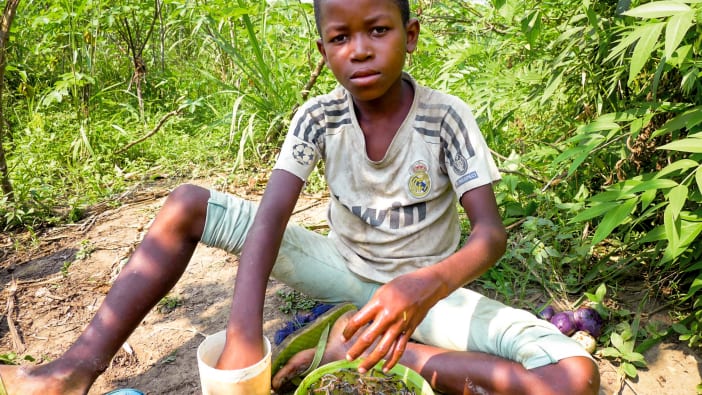Many women process food using traditional methods, which are often time-consuming. New technologies may improve processing, but are not always adopted, especially in rural areas. Although the technology seems appropriate to the people who design them (usually men), they are often not appropriate for the women who use them.
In Dozéré village in Ivory Coast, a study was carried out to look at ways of improving food processing. Researchers stayed in the village, observing and taking part in community activities, listening to people and asking questions. They observed women using different ways of food processing, and discussed any problems. The women’s ideas for improvements were discussed and prioritised. Their main problem was the hard and tiring work of extracting oil from the fruit of the oil palm (Elaeis guineensis).
Palm oil is an important oil, particularly in rural West Africa. Most is used in the home, while some is sold in local markets. Men cut the fruit from wild palms. The women cook it in oil drums. Young men usually pound it with pestles in a big mortar. The women then mix the mass of fruit pulp and seeds with water. The seeds settle to the bottom. The fibres are washed and squeezed to remove the oil. The resulting mixture of oil and water is boiled for about two hours. After cooling, the palm oil is skimmed off. The women find the hand-squeezing of the fibres very hard work.
Criteria for improvement
Considerable care needed to be taken in finding the right improved technology. The technology needed to reduce work and bring in more money. The equipment had to be strong and reliable and able to be maintained locally. Women needed to be able to operate the technology and to pay for it – each woman could afford to pay just US $6 a month.
The first step was to see if anyone in the region knew of another way of extracting oil. However, none was found. The next step was to seek information from research institutes and literature on small-scale palm oil extraction. The screw press designed by the Royal Tropical Institute (KIT) in Amsterdam met the criteria best.
Women test and adapt
A sample press was built by local manufacturers near Abidjan. The women tested it for a year. They had many ideas to improve it. The central cage was replaced by a lighter one. Handles were added to make it easier to carry. Two more cooking and reheating drums were added to the existing two, so more women could work at the same time.
After trying out the machine, the women agreed to buy the screw press. They did this collectively, by paying into a fund over six months. The women’s leader was responsible for the press, while three young women trained people using it for the first time. For this service they were given a small amount of the oil produced.
With the new press, about 11% more oil could be extracted and the amount of fuel wood needed was reduced by a quarter. Less water was needed for washing. The oil was of better quality and stored well. Using the press made the work much easier than using the traditional method.
Confidence grows
At first, just a fifth of the women used the new press to extract their palm oil. However, within two years nearly all the women used the press. At first, many women processed only small amounts of fruit, fearing the oil would not keep as long as the traditional methods. Soon, however, many women used it to process all their oil palm fruit.
Sharing information
A reliable local manufacturer was found that could produce the press to order. Women’s leaders, project workers, technical school directors and many others were invited for a demonstration day. Word began to spread. The manufacturer sold two presses in the first year and eight in the second. Hopefully this will provide a good basis for spreading this improved technology.
This approach was a very careful one. The technology was developed and tested together with the end users. Women shared their specific problems, tested the technology and suggested improvements. As in most situations, the end users of the technology are the best people to work with.
Adapted from a longer article by Barbara Böni who carried out this research with the Institute of Food Technology, Switzerland. She now works as a consultant with UNDP in Vietnam.
Technical advice
It is usually better to buy food-processing equipment from local suppliers. They can service or repair the equipment, their costs are generally lower than imported equipment and they can obtain spare parts faster and more easily. However, sometimes the quality of their work and their ability to repair equipment can be inadequate. Improving the range and quality of food processing equipment, particularly with the use of stainless steel parts (to avoid rusting), are seen as priorities by development agencies and government institutions in many countries.
People who want to buy imported equipment have a number of problems. First, they may find it difficult to get useful information. Many overseas suppliers are reluctant to meet small orders or unwilling to export their equipment. In addition, importing goods can be very complicated and expensive.
However, information about equipment is increasingly available on the internet. People wanting to process food can ask for advice from development agencies, manufacturers’ associations or university food science departments. If the decision is made to import equipment, be sure to specify exactly what is required (many manufacturers have a range of similar products), to describe the amount of food to be processed (in kg or litres per hour) and the type of food to be processed. It is a good idea to order spare parts at the same time.
Peter Fellows is Director of Midway Technology which provides advice and consultancies for small-scale food processing.
E-mail: [email protected]








